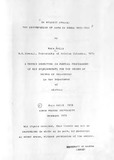| dc.description.abstract | Kenya's wildlife is justly famous. This study examines its
survival during the first half of the colonial period, both as
/"
an example of the ca paci,ties and limitations of colonial rule
and as a case study in the history of wildlife conservation.
The unusual success of wildlife preservation in Kenya is
attributable to a number of factors, of which the most important
were the timing of the establishment of the East Africa
Protectorate (later Kenya) and the influx of a small but
influential population of white settlers. In 1895, when the
Protectorate was declared, British East Africa was already
famous as a sportsman's paradise, and the swift destruction of
large wildlife popUlations in South Africa and North America
during the nineteenth centu.ry was deplored. The Foreign Office
displayed a considerable interest in game preservation, and the
Protectorate administration supported it as well, in part owing
to the financial gains that vere obtained t.hr-o uqh the sale of
ivory and the expenditures of rich European sportsmen. As this
thesis demonstrates, the wish to ensu.rethe continuation of
these sources of income, coupled with a sense of moral
.responsibilit y, led to the early promulgation of game
regulations. Subsequently, the arrival of European settlers,
many of whom had been attracted by the opportunities for sport
in the Protectorate and wished to see the game preserved,
provided an additional strong influence favouring the policy of
preservation. It vas true that the settlers did not want the
l.V
presence of game to interfere ~ith their own economic concerns,
and that. the game regulations were accordingly modified for
their convenience. But the concentration of the economic
development of the .Protectoratein the European sector, together
with the interest in preservation found among both officials and
settlers from the earliest years of British rule, permitted the
survival of large wildlife populations outside the White
Highlands until the idea of national parks took hold in the
early 1930's, The parks were intended to provide permanent
protection against the ever-increasing threats presented by
development and human population growth.
Unfortunately, the structure of game preservation policy
built during the first half of the colonial period lacked the
essential foundation of African consent •.Regulations were drawn
up and reserves designated without consulting Africans and with
little consideration of their needs. The government admitted
that it would be unjust to forbid hun·tingentirely without the
substitution of alternative means of subsistence, and the
hunting peoples primarilythe Dorobo,Boni, and Liang ulo -
were given limited rights to kill game.. This thesis shows,
however, that the restricted permission given did not embrace
the continuation of well-established economic patterns,
particularly ~ith regard to the ivory trade. In consequence, the
game regulations were widely disregarded, and poaching was a
serious problem. Attempts to discourage poaching and smuggling
met with little success. The colonial government· s resources
were limited and could not be stretched to cover the efficient
v
application of policy in the administration's many areas of
concern; hence game preservation received short financial
shrift, and law enforcement was sporadic. Preservation policy
was more impressive on paper than in reality.
The construction of a preservation policy capable of
attracting African as veIl as European support would have been
difficult. But by ignoring African interests in favour of the
maintenance of a "sportsman's paradise," the colonial regime
undermined its own success. African resistance to preservation
policy remains a threat to the survival of Kenya's wildlife
today.
This thesis, which is largely based on early European
accounts of British East Africa, British government sources, and
materials in the Kenya National Archives, examines a number of
related subjects which have not hitherto received study. The
early concern for game preservation in Kenya, resulting in the
estab1.ishment of regulations and the creation of the Game
Department, the illegal traffic in ivory which developed in
response to the colonial regime's policies, and the relationship
of game to agriculture should be of interest regarding not only
the preservation of wildlife in Africa, but in connection with
Kenya's administrative history and economic and agriCUltural
development. | en |

